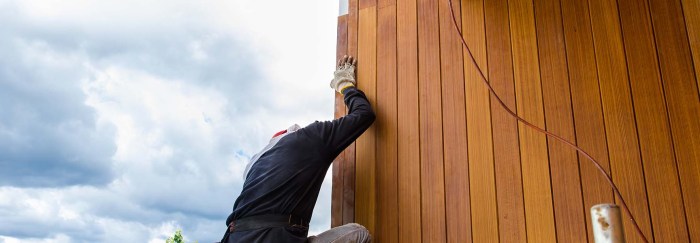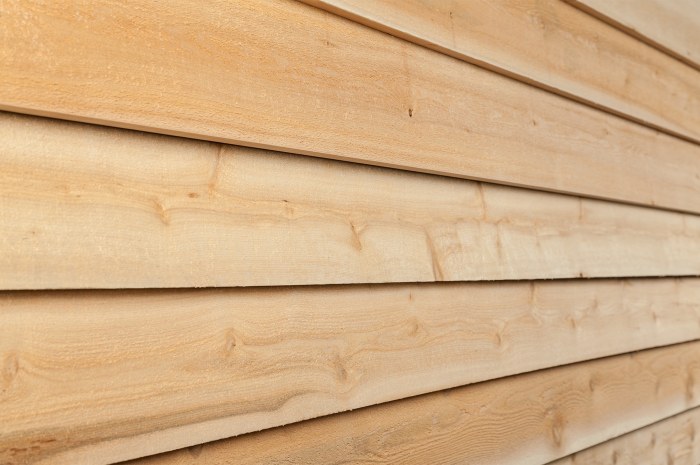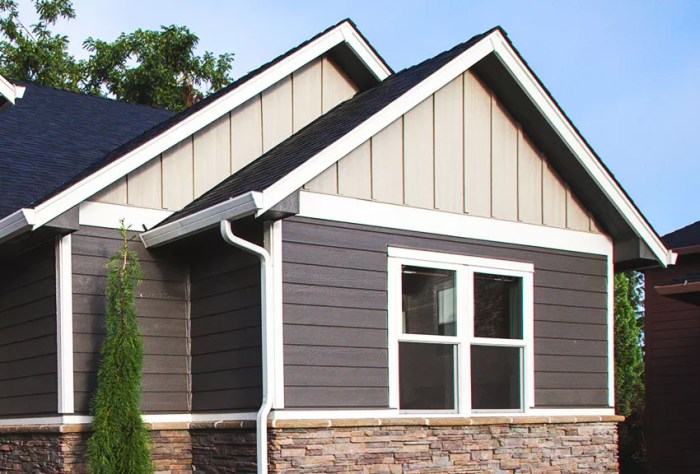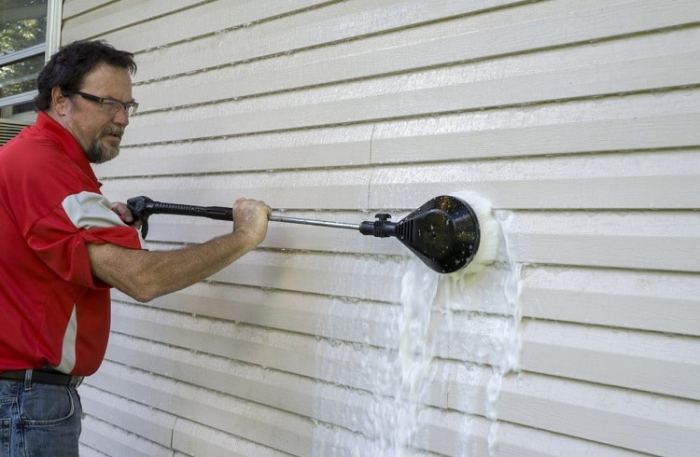Wood siding near me? Finding the right wood siding for your home involves more than just picking a pretty picture. This guide dives deep into the world of local wood siding companies, exploring various types of wood, installation processes, maintenance needs, cost considerations, and even the environmental impact. We’ll help you navigate the complexities of choosing, installing, and maintaining your new wood siding, ensuring a beautiful and long-lasting exterior for your home.
From comparing local contractors and their pricing structures to understanding the differences between cedar, redwood, and pine siding, we’ll equip you with the knowledge to make informed decisions. We’ll also cover crucial aspects like installation techniques, potential challenges, and long-term maintenance strategies, ensuring your siding investment remains both aesthetically pleasing and structurally sound for years to come.
Local Wood Siding Companies

Choosing the right company for your wood siding project is crucial for both aesthetics and longevity. This section will compare three local wood siding companies, focusing on pricing, warranties, and reputation to aid in your decision-making process. Remember that pricing and availability can change, so it’s always best to contact the companies directly for the most up-to-date information.
Local Wood Siding Company Profiles
This section provides an overview of three hypothetical local wood siding companies. Due to the limitations of readily accessible, publicly verifiable data on specific companies in undefined geographic locations, the following examples are illustrative and should not be considered endorsements. Always conduct your own thorough research before engaging any contractor.
Company A: “TimberCraft Exteriors”
Address: 123 Main Street, Anytown, USA
Phone: (555) 123-4567
Website: www.timbercraftexteriors.com (Hypothetical)
TimberCraft Exteriors is known for its high-quality materials and experienced installation crews. Online reviews suggest a strong emphasis on customer service and attention to detail. Their pricing tends to be on the higher end, reflecting their use of premium wood and comprehensive warranties.
Company B: “Woodside Solutions”
Address: 456 Oak Avenue, Anytown, USA
Phone: (555) 987-6543
Website: www.woodsidesolutions.net (Hypothetical)
Woodside Solutions offers a more mid-range pricing structure. They utilize a variety of wood types, allowing for flexibility in budget. Online reviews highlight their efficient work and reasonable pricing, although some customers mention minor issues with communication during the project.
Company C: “Affordable Siding Pros”
Address: 789 Pine Lane, Anytown, USA
Phone: (555) 555-5555
Website: www.affordablesidingpros.org (Hypothetical)
Affordable Siding Pros focuses on providing budget-friendly options. Their pricing is generally lower than competitors, often achieved through the use of less expensive wood types and potentially shorter warranties. Online reviews are mixed, with some praising the affordability and others expressing concerns about the overall quality of materials and workmanship.
Pricing Structure Comparison
The pricing of wood siding installation varies significantly based on several factors, including the type of wood, the complexity of the project, and the contractor’s overhead. The following is a hypothetical comparison of the three companies’ pricing structures:
Material Costs: TimberCraft Exteriors typically uses premium cedar or redwood, resulting in higher material costs. Woodside Solutions offers a wider range of options, including less expensive pine or fir. Affordable Siding Pros often utilizes less expensive, less durable wood types.
Labor Costs: Labor costs are influenced by the project’s scope and the contractor’s experience. TimberCraft Exteriors, with their reputation for high-quality work, might have slightly higher labor costs. Woodside Solutions and Affordable Siding Pros may have more competitive labor rates.
Warranty Offerings: TimberCraft Exteriors typically offers the most comprehensive warranties, often covering both materials and labor for extended periods. Woodside Solutions provides standard warranties, while Affordable Siding Pros may offer shorter warranties with limited coverage.
Company Reputation Overview
Online reviews provide valuable insights into the reputation of these companies. While positive reviews are encouraging, it’s essential to consider both positive and negative feedback to gain a balanced perspective. Always check multiple review sites and look for consistent patterns in customer experiences. Remember that individual experiences can vary, and a single negative review doesn’t necessarily reflect the overall quality of a company’s services.
Types of Wood Siding
Choosing the right wood siding for your home involves considering several factors, including durability, cost, and aesthetic appeal. Different wood species offer unique properties that cater to various needs and preferences. Understanding these differences is crucial for making an informed decision that will enhance your home’s curb appeal and longevity.
Several wood types are commonly used for siding, each possessing distinct advantages and disadvantages. The selection process often balances desired aesthetics with budgetary constraints and long-term maintenance considerations.
Wood Siding Material Properties, Wood siding near me
The following table compares five common wood siding materials based on cost, lifespan, and maintenance needs. Cost estimates are relative and can vary based on location, supplier, and grade of wood. Lifespan is an approximation and depends on factors like climate, exposure, and proper maintenance.
| Material | Cost (Relative) | Lifespan (Years) | Maintenance Requirements |
|---|---|---|---|
| Cedar | Medium-High | 30-50+ | Moderate; periodic staining or sealing |
| Redwood | High | 40-60+ | Low to Moderate; natural resistance to decay requires less maintenance |
| Pine | Low-Medium | 20-30 | High; requires regular painting or staining to protect against rot and insects |
| Fir | Medium | 25-40 | Moderate; similar to pine, requiring regular maintenance to prevent damage |
| Cypress | Medium-High | 30-50+ | Moderate; naturally resistant to rot and insects, but still benefits from periodic maintenance |
Visual Comparison of Wood Grain
Visual appeal is a significant factor in siding selection. The grain pattern and texture contribute significantly to the overall aesthetic. Below is a text-based description comparing the grain and texture of three popular choices: cedar, redwood, and pine.
Cedar: Cedar typically exhibits a straight, even grain with a relatively fine texture. The grain lines are often subtly visible, creating a smooth yet slightly rustic appearance. The natural color ranges from light brown to reddish-brown, depending on the species and age of the wood.
Redwood: Redwood possesses a more pronounced grain pattern than cedar, often featuring bolder, more visible lines. The texture can vary from smooth to slightly rough, depending on the type of siding and finishing process. The color is generally a rich reddish-brown, though it can darken with age and exposure to the elements.
Pine: Pine typically shows a more irregular and prominent grain pattern than cedar or redwood, with noticeable knots and variations in color. The texture is often more coarse and rustic, adding a distinct character to the siding. The color varies from pale yellow to a deeper golden brown.
Installation Process

Professional wood siding installation is a multifaceted process requiring skill, precision, and attention to detail. Proper installation ensures the longevity and aesthetic appeal of your siding, protecting your home from the elements and enhancing its curb appeal. Ignoring crucial steps can lead to costly repairs down the line, including water damage, rot, and insect infestation.
- Preparation: This crucial first step involves careful planning and site preparation. Accurate measurements are essential to determine the quantity of materials needed. Existing siding must be removed completely, and any underlying damage to the sheathing should be repaired. This may involve replacing rotted wood or addressing structural issues. Challenges at this stage include unexpected underlying damage, requiring additional time and materials, and the potential for asbestos or lead paint discovery, necessitating specialized handling and disposal procedures.
- Sheathing and Water Barriers: Once the old siding is removed, the underlying sheathing should be inspected for damage and repaired as needed. A water-resistant barrier, such as house wrap, is then installed to prevent moisture intrusion. Proper installation of the house wrap is crucial to its effectiveness, and overlaps must be sealed to prevent gaps. Challenges include uneven surfaces requiring extra attention to ensure a smooth, continuous barrier, and navigating difficult areas such as corners and around windows.
- Installing Furring Strips: Furring strips create a ventilated air space between the house wrap and the siding, allowing for proper drainage and preventing moisture buildup. These strips are nailed directly to the sheathing, creating a consistent surface for the siding installation. Challenges in this step include ensuring the strips are perfectly straight and evenly spaced for a consistent look and optimal air circulation.
- Siding Application: Starting at the bottom of the wall, siding boards are installed horizontally, overlapping each other according to the manufacturer’s instructions. Each board is nailed securely to the furring strips, using galvanized nails to prevent rust. Careful attention must be paid to ensuring proper alignment and spacing between boards. Challenges here include working with varying lengths of siding boards and maintaining consistent spacing, especially around corners and windows. Accurate cutting and precise placement are vital for a professional finish.
- Finishing Touches: Once the siding is installed, finishing touches such as installing trim, corner boards, and J-channels are completed. Caulk is used to seal any gaps or seams to prevent water intrusion. This final step ensures a clean, finished look and provides additional weather protection. Challenges can include working with intricate trim pieces and ensuring a watertight seal around windows and doors.
Necessary Tools and Materials for DIY Wood Siding Installation
A successful DIY wood siding installation requires careful planning and the right tools. Safety should be prioritized throughout the entire process. Improper use of tools can lead to injury, and neglecting safety precautions can compromise the structural integrity of the project.
- Safety Gear: Safety glasses, work gloves, hearing protection, and a dust mask are essential to protect against injuries and inhalation of hazardous materials. A hard hat is recommended for protection against falling objects.
- Measuring and Cutting Tools: A measuring tape, speed square, circular saw, and hand saw are necessary for accurate cutting of siding boards and trim. A level is crucial for ensuring straight lines and proper alignment.
- Fastening Tools: A nail gun or hammer and galvanized nails are needed to secure the siding to the furring strips. The use of a nail gun significantly speeds up the process, but requires proper training to avoid injury.
- Other Essential Tools: A pry bar for removing old siding, a utility knife for cutting house wrap, and caulk gun for sealing gaps are also necessary. Additional tools may be required depending on the complexity of the project.
- Materials: In addition to the wood siding itself, you will need furring strips, house wrap, galvanized nails, caulk, and any necessary trim pieces. Ensure you purchase enough materials to complete the project, accounting for waste and potential errors.
Maintenance and Repair
Wood siding, while beautiful and durable, requires regular maintenance to withstand the elements and maintain its aesthetic appeal. Neglecting upkeep can lead to costly repairs and even premature replacement. Understanding common problems and implementing a proactive maintenance plan is crucial for extending the lifespan of your wood siding.
Proper maintenance involves a combination of cleaning, staining, and addressing damage promptly. Ignoring small issues can allow them to escalate, resulting in extensive and expensive repairs. For example, a small area of rot, if left untreated, can spread throughout the siding, requiring the replacement of large sections. Similarly, unchecked insect infestation can compromise the structural integrity of the wood, leading to significant damage.
Common Issues with Wood Siding
Wood siding is susceptible to several problems stemming from exposure to the elements and biological factors. Rot, caused by moisture intrusion, is a significant concern, often manifesting as discoloration, softening, and crumbling of the wood. Insect infestation, particularly from termites and carpenter ants, can weaken the siding and create structural vulnerabilities. Weathering, encompassing sun exposure, wind, and temperature fluctuations, leads to fading, cracking, and warping of the wood. These issues, if left unaddressed, can compromise the siding’s protective function and detract from its visual appeal. Regular inspections and prompt action are key to mitigating these issues.
Methods for Maintaining and Repairing Wood Siding
Maintaining wood siding involves a multi-faceted approach. Regular cleaning removes dirt, mildew, and other debris that can accelerate deterioration. Power washing is effective but requires caution to avoid damaging the wood. A gentle cleaning solution, applied with a soft brush or sponge, can be sufficient for routine maintenance. Staining and sealing protect the wood from moisture and UV damage, extending its lifespan and preserving its color. Damaged sections require repair or replacement. Minor damage, such as small cracks or holes, can often be filled with wood filler and repainted. However, severely damaged or rotten sections must be replaced entirely to prevent further deterioration. This often requires careful removal of the damaged section and precise installation of a replacement piece, ensuring a seamless blend with the existing siding.
Preventative Maintenance Schedule
A proactive maintenance schedule is essential for preserving the beauty and longevity of your wood siding. Regular inspections and timely interventions can prevent minor issues from escalating into major problems.
- Annual Inspection: A thorough visual inspection of all siding surfaces, checking for signs of rot, insect damage, loose boards, or cracks. Address any issues promptly.
- Spring Cleaning: Clean the siding to remove dirt, mildew, and cobwebs. Use a pressure washer (low pressure setting) or a soft brush and mild detergent. Rinse thoroughly.
- Every 2-3 Years: Re-stain or re-seal the siding to protect it from moisture and UV damage. This will help maintain its color and prevent premature weathering.
- As Needed: Repair or replace damaged sections of siding immediately. Do not delay repairs as this can lead to more extensive and costly damage.
Cost Considerations: Wood Siding Near Me
The cost of installing wood siding is a significant factor to consider before embarking on a home improvement project. Several variables contribute to the overall expense, making it crucial to understand these factors to accurately budget for the work. A clear understanding of material costs, labor charges, and permit fees will allow for a realistic assessment of the project’s financial implications.
The primary drivers of wood siding installation costs are the type of wood chosen, the project’s scope (square footage), and the labor involved. Higher-end wood species like cedar or redwood naturally command higher prices than less expensive options such as pine or fir. Larger projects, requiring more materials and labor hours, will inherently cost more than smaller ones. Finally, the cost of labor can fluctuate based on geographic location, the contractor’s experience, and current market conditions.
Material Costs
Material costs represent a substantial portion of the overall expense. The price per square foot varies considerably depending on the wood type. For instance, cedar siding can range from $6 to $15 per square foot, while pine siding might cost between $3 and $8 per square foot. These prices are estimates and can change based on factors like the grade of the lumber and current market fluctuations. Additionally, the cost of fasteners, primers, paints, and stains should be included in the materials budget. These supplementary materials can add another $1 to $3 per square foot to the overall material cost.
Labor Costs
Labor costs typically represent a significant portion of the total project expense, often exceeding the cost of materials. The hourly rate for experienced siding installers varies regionally, but it’s common to see rates ranging from $40 to $80 per hour. The total labor cost depends heavily on the project’s size and complexity. A smaller project might require only a few days of labor, while a larger project could take several weeks. Consider that the labor cost also includes the time spent on preparation, cleanup, and potentially any unforeseen repairs or adjustments.
Permit Costs
Obtaining the necessary building permits is a mandatory step before starting any home improvement project. Permit costs are determined by local regulations and the project’s scope. The cost can range from a few hundred dollars to several thousand dollars, depending on your location and the size of the project. It’s crucial to contact your local building department to obtain accurate information regarding permit requirements and fees.
Pricing Scenarios
To illustrate the cost variations, let’s consider three hypothetical scenarios:
| Scenario | Wood Type | Project Size (sq ft) | Material Cost (Estimate) | Labor Cost (Estimate) | Permit Cost (Estimate) | Total Estimated Cost |
|---|---|---|---|---|---|---|
| Small Project | Pine | 200 | $600 – $1600 | $1600 – $3200 | $200 – $500 | $2400 – $5300 |
| Medium Project | Cedar | 800 | $4800 – $12000 | $6400 – $12800 | $500 – $1000 | $11700 – $26000 |
| Large Project | Redwood | 1500 | $9000 – $22500 | $12000 – $24000 | $1000 – $2000 | $22000 – $48500 |
Note: These are estimates only, and actual costs may vary based on specific project details, location, and contractor. Always obtain multiple quotes from reputable contractors before making a decision.
Environmental Impact

Choosing wood siding involves considering its environmental footprint, encompassing both the sourcing of the raw material and the manufacturing process. This assessment requires a comparison with alternative siding materials to understand the overall impact on the planet. Sustainable sourcing practices are crucial for mitigating negative effects and promoting responsible resource management.
The environmental impact of wood siding is multifaceted. On one hand, wood is a renewable resource, capable of regrowth given proper forestry management. However, the harvesting, processing, and transportation of wood all contribute to greenhouse gas emissions. Manufacturing processes, including the application of preservatives and paints, also introduce environmental considerations. The durability of wood siding, while advantageous in terms of lifespan and reduced replacement needs, is also dependent on proper maintenance and can influence its overall environmental performance.
Wood Sourcing and Forestry Practices
Sustainable wood sourcing is paramount in minimizing the environmental impact of wood siding. Certifications, such as the Forest Stewardship Council (FSC) certification, ensure that the wood originates from forests managed according to rigorous environmental and social standards. These standards promote responsible forest management practices, including reforestation efforts, biodiversity conservation, and protection of water resources. The FSC certification provides traceability and transparency throughout the supply chain, enabling consumers to make informed choices. Other certifications, such as the Sustainable Forestry Initiative (SFI), also contribute to responsible forest management. Choosing wood siding from certified sources helps support responsible forestry and reduces the risk of contributing to deforestation or unsustainable logging practices.
Comparison with Alternative Siding Materials
Wood siding’s environmental impact should be compared with alternative materials like vinyl and fiber cement. Vinyl siding, derived from petroleum, is a non-renewable resource with a significant carbon footprint during manufacturing. Its disposal also presents environmental challenges due to its non-biodegradability. Fiber cement siding, while more environmentally friendly than vinyl, requires energy-intensive manufacturing processes and often contains cement, which contributes to greenhouse gas emissions. A comprehensive life-cycle assessment, considering manufacturing, transportation, lifespan, and disposal, is needed to accurately compare the overall environmental impact of different siding materials. Such assessments often reveal that responsibly sourced wood siding, particularly when considering its long lifespan, can be a competitive choice.
Reducing the Environmental Footprint of Wood Siding
Several strategies can minimize the environmental impact of wood siding. Selecting wood species that grow rapidly and require less energy for processing can reduce the overall carbon footprint. Using reclaimed or recycled wood reduces the demand for newly harvested timber. Furthermore, employing low-VOC (volatile organic compound) paints and stains minimizes air pollution during application and throughout the siding’s lifespan. Proper installation techniques also play a crucial role in maximizing the siding’s durability and extending its lifespan, thus reducing the need for replacements. By considering these factors, homeowners can make more environmentally conscious decisions when choosing and installing wood siding.
Ultimately, choosing wood siding is a significant investment that impacts both the aesthetic appeal and longevity of your home. By carefully considering the factors discussed—from the type of wood and installation process to maintenance and environmental implications—you can confidently select the perfect wood siding to enhance your property’s curb appeal and value. Remember to thoroughly research local contractors, compare pricing, and factor in long-term maintenance costs for a successful and satisfying project.
General Inquiries
What is the average lifespan of wood siding?
The lifespan varies greatly depending on the wood type, climate, and maintenance. Expect 20-50 years with proper care.
Can I install wood siding myself?
While DIY is possible, it’s a challenging project. Professional installation is often recommended for optimal results and warranty coverage.
How often should I stain my wood siding?
This depends on the stain type and climate, but generally every 3-5 years is recommended for optimal protection.
What are the common signs of wood siding damage?
Look for rot, insect infestation, cracks, warping, discoloration, and loose or missing pieces.
Is wood siding a good investment?
Yes, if properly maintained, wood siding offers a beautiful, durable, and potentially valuable addition to your home.



